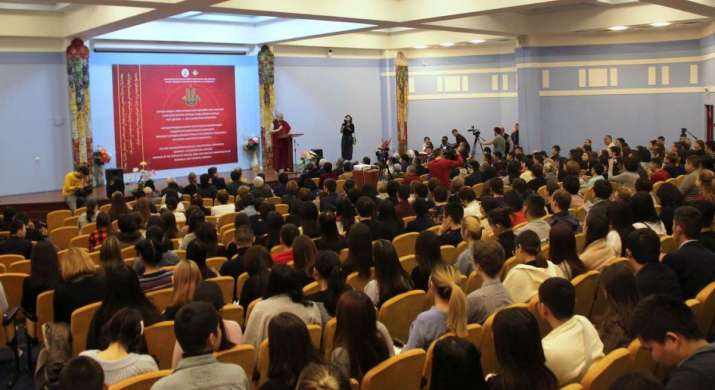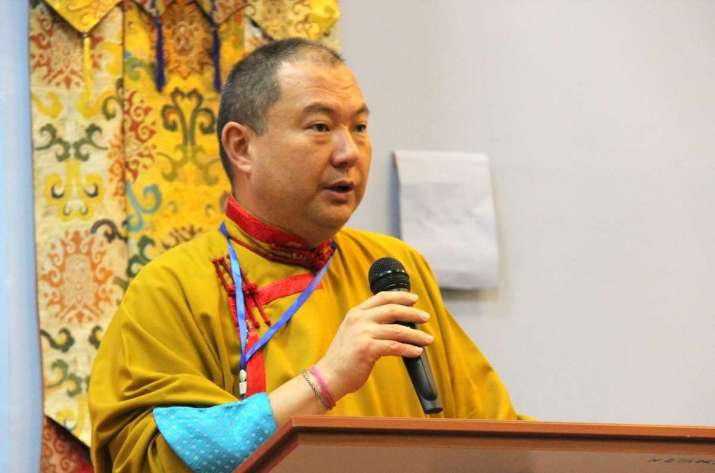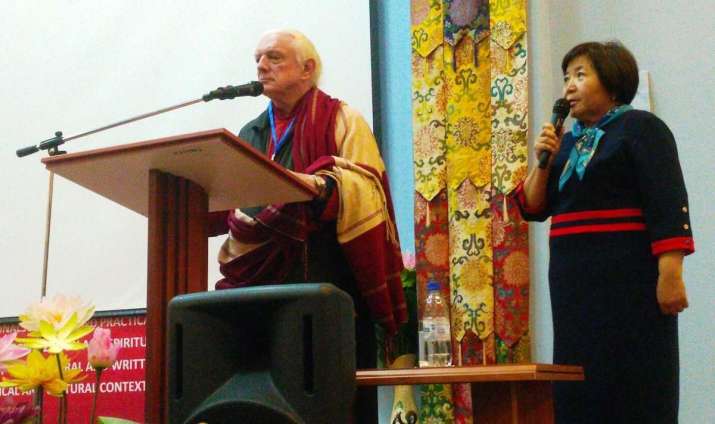
The first international conference “Buddhist Civilization and the Spiritual Heritage of the Peoples of Eurasia: Oral and Written Traditions in a Historical and Cultural Context” was held in the Russian republic of Kalmykia on 15–16 November, dedicated to the 420th anniversary of the birth of the prominent Oirat Buddhist scholar Zaya Pandita Namkhai Jamtso (1599–1662).
One of the main goals of the conference was to draw the attention of the scientific community in Russia and overseas to the problems of preserving Buddhism’s written heritage. The scientific forum played an important role in the process of determining future prospects for the development of historical, cultural, interfaith, and language interaction in Eurasia. Buddhologists and linguists from Canada, China, the Czech Republic, Germany, Hungary, India, Kazakhstan, Mongolia, and various parts of Russia participated in the international event.
Telo Tulku Rinpoche, the honorary representative for His Holiness the Dalai Lama in Russia, Mongolia, and the Commonwealth of Independent States, opened the conference and also gave a presentation on “Perspectives and Development of Buddhism in the Russian Federation and Former Soviet Republics.” During his talk, Telo Rinpoche emphasized that Buddhism is not only a religion but also a philosophy and a science, stating: “The Buddhist tradition originated in India and was then introduced to Tibet, and later to Mongolia and Russia. Russia being one of the largest countries on the planet, spanning two continents—Asia and Europe—plays an important role in bridging Eastern and Western spiritual traditions and also for the preservation of peace and harmony.” (Golden Abode of Shakyamuni Buddha)

The conference was organized by the Central khurul (temple) of Kalmykia, the Golden Abode of Shakyamuni Buddha, and the Kalmyk State University named after B. B. Gorodovikov, with the participation of the Institute of Oriental Studies of the Russian Academy of Sciences, the Institute of Oriental Manuscripts of the Russian Academy of Sciences, the International Association of Mongolists, the Institute of History and Archeology of the Mongolian Academy of Sciences, the Institute of Language and Literature of the Mongolian Academy of Sciences, the Institute of Philosophy of the Mongolian Academy of Sciences, the Institute of Mongolian Studies of the National University of Mongolia, and others.
Among the distinguished participants was the renowned Canadian Tibetologist, Buddhist writer, and teacher of Tantric Buddhist meditation,Glenn Mullin. Mullin presented on Tibeto-Mongolian Buddhism in the modern world and spoke about how he became a student of one of the highest lamas of Mongolia, Dilav Khutagt Bashlugijn Zhamsranzhav* (1884–1965), a respected politician and scholar, and recognized as a reincarnation of the Indian mahasiddha Tilopa (988–1069). The next reincarnation of Tilopa after Zhamsranzhav is Telo Tulku Rinpoche, the shadjin lama (head lama) of the Kalmyk people.
Another key speaker during the conference was the lead editor of the journal Buddhism in Russia published in St. Petersburg, Andrey Terentyev, who acted as interpreter for His Holiness the Dalai Lama during his visit in Kalmykia in 1991. The Russian scholar talked about “Buddhism in Russia: Royal, Soviet, and Post-Soviet.”

Most of the presentations were dedicated to the unknown pages of the history of Buddhism, Oirat written language and literature, and their historical role in the development of science and education. Assessing the contribution of Zaya Pandita to the cultural heritage of the Mongolian people was the other important focus. The presentations aroused considerable interest among the Kalmyk people, international participants, and guests, and particularly among the youth of the Russian Buddhist republic.
Zaya Pandita Namkhai Jamtso was a Buddhist monk of the Khoshut tribe of the Oirats, the westernmost group of the Mongols. The Khoshuts were first recorded in 1580 and by 1620 had become the most powerful Oirat tribe, notable for widely propagating Buddhism. In 1615, Zaya Pandita traveled to Tibet to study and practice Buddhism, and spent several years in Lhasa under the guidance of Lobsang Chokyi Gyaltsen, the fourth Panchen Lama. In 1638, he left Tibet to conduct missionary work among the Mongols. He spread the Gelug schoolof Tibetan Buddhism to the Oirats, the Khalkha (the largest subgroup of Mongols), and the Kalmyk people in far away Russia. He composed a new writing system based on the traditional Mongolian alphabet, called “clear script” (todo bichig), to transcribe the Oirat language, and translated 186 Buddhist texts from Tibetan to Oirat. “Clear script” remained in use in Kalmykia until 1920, when it was replaced by a Latin-based script and later the Cyrillic alphabet. In Mongolia it was replaced by the Cyrillic alphabet in 1941.

* Alternative spellings: Dilav Khutagt B. Jamsaranjab, Dilov Khutagt B. Jamsaranjav, Diluwa Khutugtu Jamsrangjab, Dilowa Khutukhtu.
See more
I Международная научно-практическая конференция (Золотая обитель Будды Шакьямуни)
Закрытие I Международной научно-практической конференции, посященной великому ойратскому просветителю Зая-пандиты Намкай Джамцо (Золотая обитель Будды Шакьямуни)














